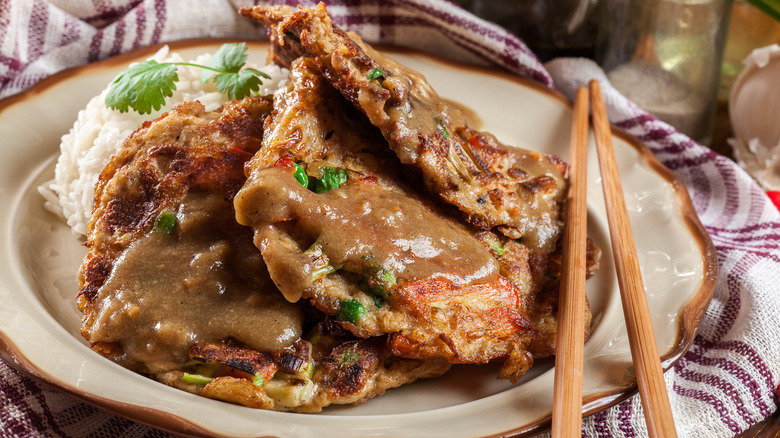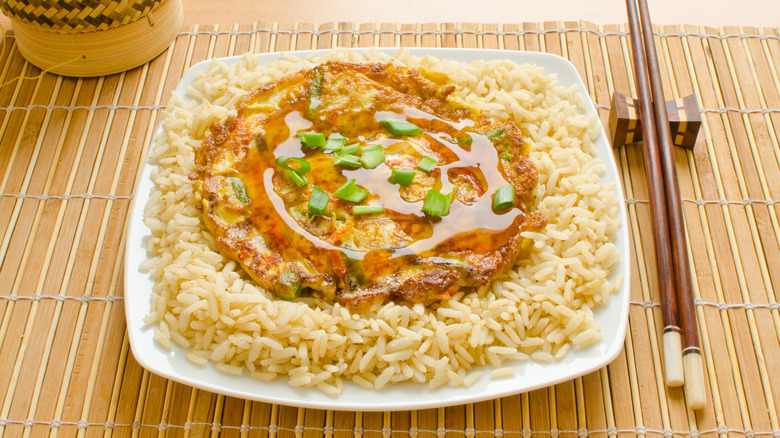The Untold Truth Of Egg Foo Young
When it comes to Chinese food in America, there tends to be a standard roster of items found on restaurant menus. According to a 2015 GrubHub survey, the most popular Chinese dish stateside was General Tso's chicken, followed by crab Rangoon and egg rolls. Not making the list, however, was egg foo young. The gravy smothered delight used to be one of the most well-known dishes in the United States, but it has faded into obscurity over the last few decades (via Phoenix New Times). In fact, there is a whole generation of diners that is likely unfamiliar with the former Chinese restaurant staple.
According to From Hunger to Hope, egg foo young's name comes from the phrase "hibiscus egg" in Cantonese. Like many American Chinese restaurant favorites, it actually originated here and reflects both East and West culinarily sensibilities. From the dish's fascinating origins to its rise and fall from the zeitgeist, this is the untold of egg foo young.
Egg foo young is more than just an omelet
So what exactly is egg foo young? Well, it's basically a pancake, fried fritter, and omelet all in one. The secret to good egg foo young is how well the ingredients are mixed. Done right, it becomes fluffy and delicious. If the ingredients are out of balance, then it may come out hard or too soft. According to The Spruce Eats, the key to getting the right consistency is to lightly beat the eggs and then stop before any bubbles form. Likewise, frying egg foo young is a big part of how it gets its notable texture. The eggs along with various ingredients such as shrimp, scallions, and other veggies are whisked together in a bowl before being cooked on both sides in a hot pan.
The dish's texture isn't surprising when you consider the origins of egg foo young. It was created in the United States, where fried foods were already popular. Similar options like pancakes and omelets were already being prepared, and the same cooking techniques were applied to egg foo young. For many home chefs, an egg foo young recipe is a simple addition to their repertoire, especially if they are familiar with pan-frying in a hot wok.
Egg foo young is all about the sauce
Egg foo young is often served with a delicious brown mushroom sauce. Mushrooms are a staple in cooking around the world because of their savory flavor profile. French and Asian cooking styles, in particular, use mushrooms to create decadent sauces with a touch of umami. In this case, it is a mushroom-flavored gravy that helps give egg foo young its signature look and taste. To make the thick sauce, combine Chinese rice wine, chicken broth, soy sauce, and sesame oil and bring it to a boil, before adding a slurry of cornstarch and water to the mixture (via The Spruce Eats).
The mushroom gravy is also a part of how egg foo young got a bad reputation. According to The Chicago Tribune, many restaurants looking to simplify this dish wouldn't put much effort in preparing the gravy. A poor seasoned gravy made simply from cornstarch and soy sauce is not a well made one. It might be a reason why some people stay far away from egg foo young. Fortunately, there are restaurants that serve this dish with a delectable mushroom gravy that egg foo young should have.
Chinese food became popular in the U.S. via Cantonese immigrants
According to Saveur, the story of how egg foo young established roots in the United States can be traced back to the mid-19th century, when immigrants from Canton settled in California due to the Gold Rush. Canton was an area in China now known as Guangzhou (via Mental Floss). The city was never officially called Canton, but the name likely stems from a mispronunciation from European visitors.
By 1851, 25,000 Chinese immigrants moved to California as a result of the Gold Rush (via FamilySearch). According to Time, many of America's first Chinese restaurants started in mining towns to feed those involved in the Gold Rush, and then expanded to feed loggers and railroad workers. Another 322,000 immigrants came to the United States as a part of the 1868 Burlingame-Seward Treaty, which eased immigration restrictions (via U.S. Department of State). Most of these immigrants didn't find their fortunes in gold and couldn't afford to return to China. As a result, they started their life in the U.S., working to construct railroads and build Chinese-owned businesses, including fisheries and laundries. One of the most common businesses that Chinese immigrants started was restaurants. Many of these Chinese restaurants served fellow Chinese immigrants, as well as some other Americans willing to try the food.
There's a debate over which food inspired egg foo young
According to Viet World Kitchen, egg foo young came about during the Gold Rush period, and the original preparation likely consisted of small, crispy egg pancakes. It is unclear precisely which dish inspired egg foo young. There are several possible candidates from different regions. The Cantonese fu rong with custardy eggs mixed with other ingredients is a popular candidate. There is also the Shanghai-inspired fu yung which has egg whites and chopped ham. Egg foo young has similarities to dishes from other schools of cooking as well, including French cuisine. It is often compared to an omelet from France, with a slightly different preparation. Other countries have their own varieties of egg pancake, including the Vietnamese trung chien tom which is made with eggs, scallions, and shrimp. In Indonesia, it is called fu yung hai and you serve it with sweet and sour sauce. A Chinese and Indonesian influenced version in the Netherlands called foe young hai is served with a sweet tomato sauce (via Wind Chimes Chinese Restaurant).
Tracking down the exact origin of egg foo young may be impossible at this point, as its history is murky at best. Not only is its origins under dispute, but it has changed so much that it is difficult to determine where the search should start. Which version of egg foo young is the closest to the original? It is a question that makes finding the origin of this Chinese food favorite difficult, if not impossible.
Americans originally thought Chinese food was suspicious
Chinese food wasn't always so welcomed in the United States, per NPR. In fact, the earliest Chinese restaurants catered specifically to Chinese immigrants because white Americans found the restaurants and food options to be suspicious at best.
There is a long history of distrust between white Americans and Chinese immigrants, and it has had an effect on how the two groups interacted. From being exploited for cheap labor to being ostracized, Chinese immigrants faced plenty of adversity when they arrived and these hurdles extended to restaurant owners. According to NPR, Many Americans simply did not know much about Chinese food, and the combination of ignorance and racism fueled much of this distrust. Rumors started to circulate that were completely baseless about the quality of the ingredients that were used. Ultimately, these falsehoods gained a foothold in people's minds and gave Chinese food a bad name. Fortunately, much of that misinformation has been reversed.
Egg foo young was adapted to satisfy American palates
It is often a struggle to get people to try new things, so it was no surprise that Chinese restaurant owners put in a lot of effort to ensure their menu would be accepted by an American audience. According to Saveur, egg foo young is one of a handful of Chinese dishes that has been adapted to suit the preferences of the American palate. This means taking the more unfamiliar ingredients out and developing a recipe that wouldn't be entirely foreign to white American diners.
By taking a traditional dish and reconfiguring it into egg foo young, gaining a foothold in the food industry became much easier. Chinese restaurants grew in popularity for a variety of reasons, but the fact that menus began to include more options that catered to a much wider audience played a significant role. The addition of egg foo young is just one part of that process.
Aside from making egg foo young a better fit for American eaters, there is another practical reason why the recipe had to change. Not all of the ingredients needed to make egg foo young (or rather, the dish or dishes it was based on) could be procured in the United States. According to The Phoenix New Times, the original recipe was adapted to accommodate for what ingredients were available in the U.S. at the time, which is different from what was available in China. Over time, some of these changes stuck despite the growing availability of different food options.
Egg foo young became popular in chop suey houses
Before Chinese food became a mainstream option, restaurants that served it struggled to find acceptance. According to Fork+Plate, Chinese restaurants were referred to as "chop suey joints" instead of restaurants. Chop suey, which was made from whatever meat and vegetable ingredients were on hand, stir-fried and served with rice, was also a popular option on the menu at the time. Fortunately, this lack of mainstream acceptance did not last, and Chinese restaurants exploded in popularity. According to American Heritage, most Chinatown restaurants had a chop suey sign on their door in the 1940s. The U.S. and China became allies in the fight against Japan and the Axis Powers in WWII, which changed a lot of people's opinions of Chinese immigrants and Chinese culture in general.
Chop suey houses became so popular, that the concept of a chop suey house became a frequent reference in pop culture, including "Cornet Chop Suey," a song by Louis Armstrong (via American Heritage). In many ways, this trend continued with movies, art, and, of course, food as Chinese restaurants rose in popularity. Diners would become well acquainted not only with chop suey, but other popular menu items such as egg foo young.
Chop suey houses used stories to encourage customers to try food
Many Americans weren't used to foods that you'd find on a Chinese menu. Many menu options held a stigma because people simply did not understand what they were or even what to order. To make it easier for customers to want to try something new, restaurants began telling stories about different dishes so that patrons would be willing to try them. These stories were printed directly on the menu to try to persuade people to engage with a new food item and order it.
According to The New York Times, to encourage diners to try these new foods, many restaurants had historical facts, made up legends, and stories to explain exotic origins of dishes. This method worked well, although those stories may not have always been entirely accurate. It's a trend that continues today with restaurants that use storytelling to explain their brand and food choices to customers who might otherwise look elsewhere.
Egg Foo Young became standardized in the mid-1900s
According to Saveur, the egg foo young that you would find today was standardized in the mid-1900s to include an egg omelet-like dish with protein, water chestnuts, and bean sprouts over rice. This standardization makes it easier for new customers to understand what egg foo young is and what they should expect, ultimately improving widespread adoption and sales. Before this, it was a toss up trying to figure out what you could expect out of egg foo young, which could be a welcome or alarming decision depending on your point of view.
Still, there remained some variations on the dish. According to Wind Chimes Chinese Restaurant in Dublin, Ohio, Midwestern Chinese restaurants might serve egg foo young with bread. The dish, called the St. Paul Sandwich, features mayonnaise, pickles, and other sandwich toppings such as lettuce and tomato. In some places, egg foo young isn't served with the sauce that it's known for.
There are different ways to spell egg foo young
Like many other things with a long history, egg foo young has undergone several changes in its lifetime. One of the most prominent changes is the way that it is spelled. According to Melissa Joulwan's Well Fed, there are many different ways to spell egg foo young in the U.S., including egg fu yung and egg furong.
Some of the names take a phonetic approach while others are likely misspellings based on mispronunciations used over the years. Whatever the case, the different spellings have been used by people both in and outside of the restaurant industry to spell a dish that is always popular.
Many of these spellings likely came from the restaurants themselves. Since it is a Chinese-American dish, there isn't a standardized way of spelling its name. This goes along with the variations in the way it's made and the stories restaurants tell about where it came from. Regardless, it's a delicious menu option no matter how you spell it.
The focus on authentic Chinese flavors in the 1970s hurt egg foo young's popularity
There's no doubt that egg foo young is an American food, with Chinese influences. According to Viet World Kitchen, people wanted to start eating more authentic versions of Chinese food starting in the 1970s. This coincided with President Richard Nixon's visit to China (via Forbes). This visit put a spotlight on the differences between American Chinese food and traditional Chinese food. To accommodate, many restaurants focused on more traditional menu options.
This downturn in popularity did not spell the end of egg foo young though. It is still on the menu in many places and many home cooks now make it at home. Its light and fluffy texture, decadence flavors, and all-around appeal keep it on Chinese food menus across the country. Some restaurants are even continuing the trend of trying to make their own special versions and featuring them alongside other popular options. Egg foo young is sure to continue to be a favorite for Chinese food lovers across the United States.











